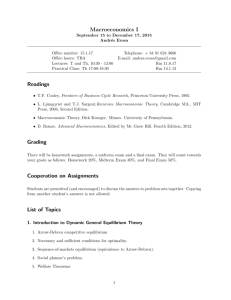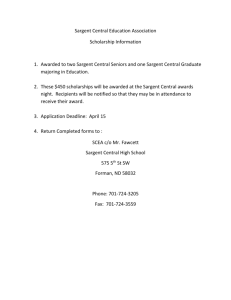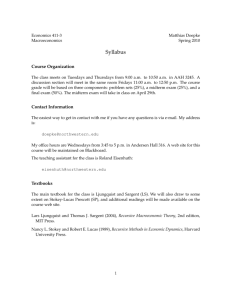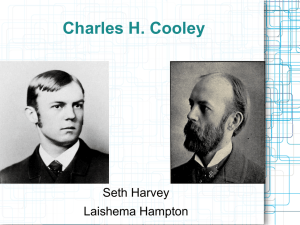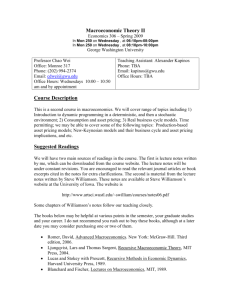Macroeconomic - University of Southern California
advertisement
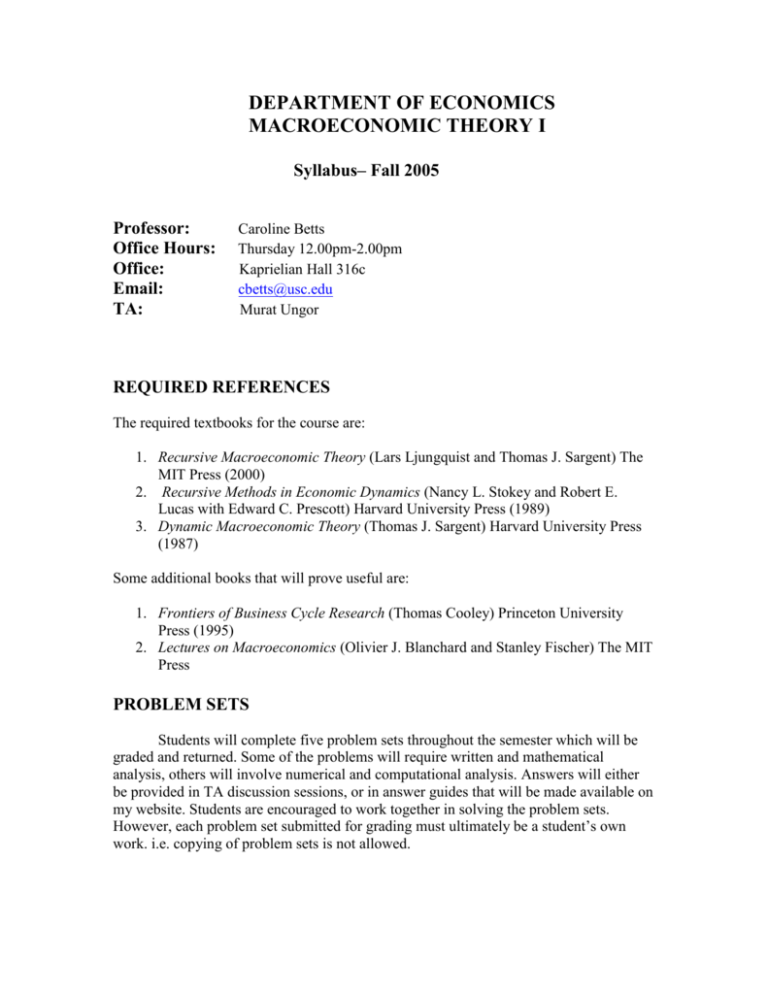
DEPARTMENT OF ECONOMICS MACROECONOMIC THEORY I Syllabus– Fall 2005 Professor: Office Hours: Office: Email: TA: Caroline Betts Thursday 12.00pm-2.00pm Kaprielian Hall 316c cbetts@usc.edu Murat Ungor REQUIRED REFERENCES The required textbooks for the course are: 1. Recursive Macroeconomic Theory (Lars Ljungquist and Thomas J. Sargent) The MIT Press (2000) 2. Recursive Methods in Economic Dynamics (Nancy L. Stokey and Robert E. Lucas with Edward C. Prescott) Harvard University Press (1989) 3. Dynamic Macroeconomic Theory (Thomas J. Sargent) Harvard University Press (1987) Some additional books that will prove useful are: 1. Frontiers of Business Cycle Research (Thomas Cooley) Princeton University Press (1995) 2. Lectures on Macroeconomics (Olivier J. Blanchard and Stanley Fischer) The MIT Press PROBLEM SETS Students will complete five problem sets throughout the semester which will be graded and returned. Some of the problems will require written and mathematical analysis, others will involve numerical and computational analysis. Answers will either be provided in TA discussion sessions, or in answer guides that will be made available on my website. Students are encouraged to work together in solving the problem sets. However, each problem set submitted for grading must ultimately be a student’s own work. i.e. copying of problem sets is not allowed. EXAMINATIONS There will be a midterm examination, on Tuesday, October 4th in class time, and a final examination which is held during the regular examination period in December. If you cannot attend the midterm due to a verifiable medical emergency, then the weight of the midterm will be added to the final examination. Otherwise, a grade of 0 will be assigned to the midterm. If you cannot attend the final examination due to a verifiable medical emergency, then a makeup examination will be set as soon as possible. Otherwise, a grade of 0 will be assigned to the final exam. EVALUATION The exact breakdown of the evaluation of each student’s work in the course is as follows: Problem Sets Midterm Final Exam : : : 30% 30% 40% No exceptions will be made to this grading scheme. ACADEMIC ACCOMODATIONS Any student requesting academic accommodations based on a disability is required to register with Disability Services and Programs (DSP) each semester. A letter of verification for approved accommodations can be obtained from DSP. Please be sure the letter is delivered to me as early as possible in the semester. DSP is located in STU 301, and is open 8.30am-5.00pm, Monday through Friday. The phone number for DSP is (213)-740-0776. ACADEMIC DISHONESTY I refer all of you to the University’s guidelines on academic integrity for students. Be aware that the penalties for graduate students are generally stricter than those for undergraduate students. You are all subject to these guidelines, and in the event of any violation I would seek the strongest possible penalty. COURSE OUTLINE I ECONOMIC GROWTH FACTS *Lecture notes *Cooley, Chapter 1 Chari, Kehoe and McGatten (online paper) Barro and Sala-i-Martin, Chapter 1 (Xeroxes will be made available). II THE SOLOW GROWTH MODEL *Lecture notes Barro and Sala-i-Martin, Chapter 1 (Xeroxes will be made available). III ARROW DEBREU EQUILIBRIA, SEQUENTIAL MARKETS AND PARETO OPTIMALITY IN SIMPLE DYNAMIC ECONOMIES *Lecture notes #1 by Dirk Krueger *Ljungquist and Sargent, Chapter 7 Negishi, T. (1960) “Welfare Economics and Existence of an Equilibrium for a Competitive Economy”, Metroeconomica, 12, 92-97 *Kehoe, T. (1989) “Intertemporal General Equilibrium Models”, in F. Hahn (ed.) The Economics of Missing Markets Clarendon Press VI THE NEOCLASSICAL GROWTH MODEL AND DYNAMIC PROGRAMMING *Lecture notes #2 by Dirk Krueger (#3 optional) Cooley Chapter 1 Ljungquist and Sargent Chapters 2-4 Stokey et al Chapters 2-4 Sargent Chapter 1 V THE WELFARE THEOREMS IN INFINITE DIMENSIONS *Lecture notes #4 by Dirk Krueger Stokey et al Chapters 15 and 16 Gerard Debreu (1983) “Valuation Equilibrium and Pareto Optimum”, in Mathematical Economics: Twenty Papers of Gerard Debreu Cambridge University Press VI THE OVERLAPPING GENERATIONS MODEL *Lecture notes #5 by Dirk Krueger *Ljungquist and Sargent Chapters 8 and 9 Blanchard and Fischer Chapter 3 Sargent Chapter 7 *Barro, R. (1974) “Are Government Bonds Net Wealth?” Journal of Political Economy, 82, 1095-1117 Diamond, P. (1965) “National Debt in a Neo-Classical Growth Model”, American Economic Review, 55, 1126-1150 Gale, D. (1973) “Pure Exchange Equilibria of Dynamic Economic Models”, Journal of Economic Theory, 6, 12-36 *Kehoe, T. (1989) “Intertemporal General Equilibrium Models”, in F. Hahn (ed.) The Economics of Missing Markets Clarendon Press VII BUSINESS CYCLE FACTS *Lecture notes *Cooley Chapters 1 and 8 *Hodrick, R. and Edward C. Prescott (1997) “Post-War Business Cycles: A Descriptive Empirical Investigation”, Journal of Money, Credit and Banking, 29, 1-16 VIII BUSINESS CYCLE MODELS AND EMPLOYMENT FLUCTUATIONS *Lecture notes *Hansen, Gary D. and Randall Wright (1992) “The Labor Market in Real Business Cycle Theory”, Federal Reserve Bank of Minneapolis Quarterly Review *Cooley, Chapters 5 and 6 Kydland and Prescott (1982) “Time to Build and Aggregate Fluctuations”, Econometrica, 50, 1345-1370 Lucas, R.E. (1987) Models of Business Cycles New York: Basil Blackwell Hansen, Gary D. “Indivisible Labor and the Business Cycle”, Journal of Monetary Economics, 16, 309-327 IX INTERNATIONAL BUSINESS CYCLES *Lecture notes *Cooley Chapter 8 *Backus, Kehoe and Kydland (1990) “International Real Business Cycles”, Journal of Political Economy, Mendoza, Enrique (1989) “Real Business Cycles in a Small Open Economy;” American Economic Review, Betts, Caroline and Timothy J. Kehoe “Tradability of Goods and Real Exchange Rate Fluctuations,” mimeo. University of Minnesota and University of Southern California
